Installation of solar panels price
In the following section we will explain you the different prices that solar installations can have depending on their components and power range.
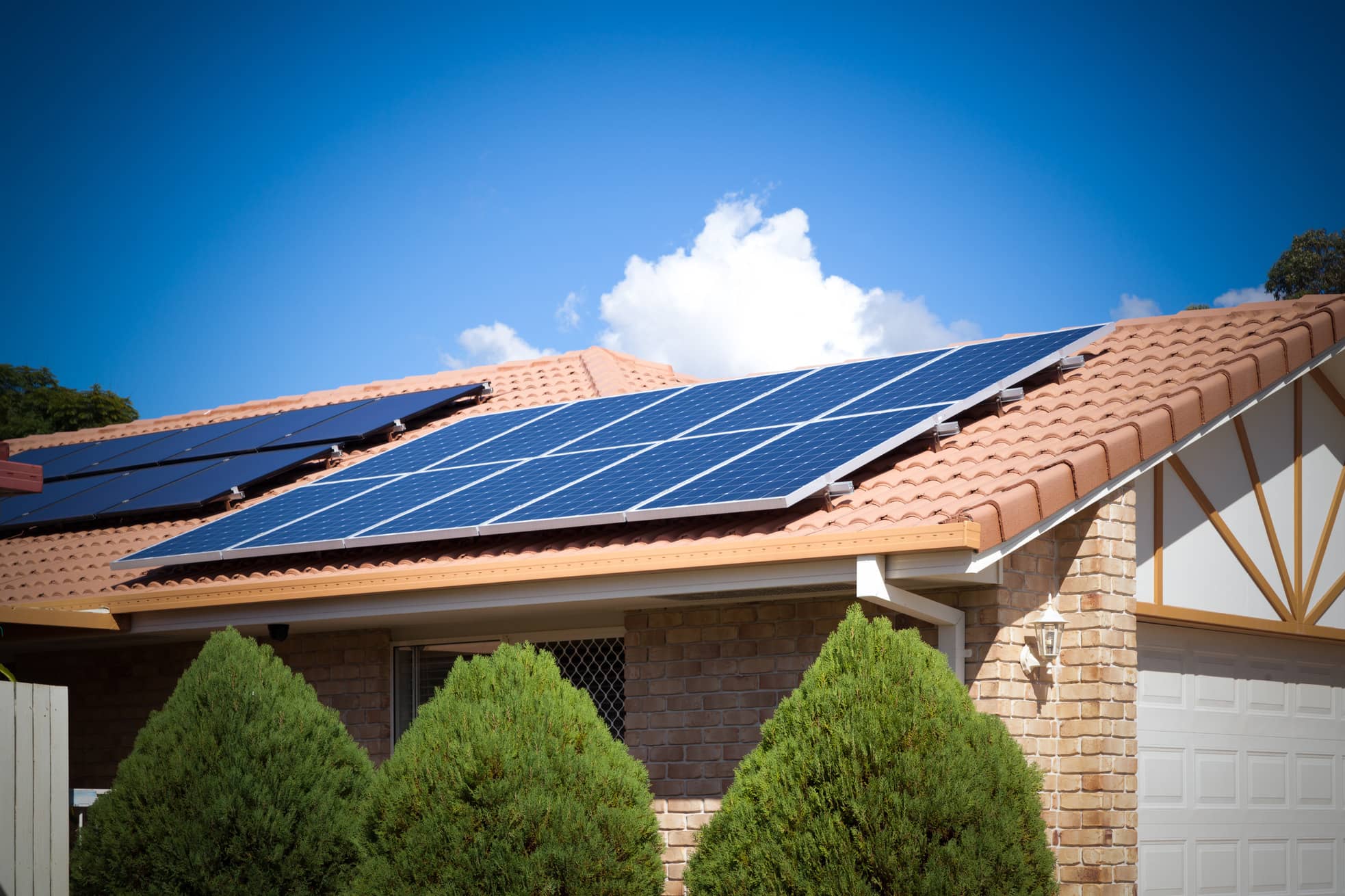
Are you looking to understand the world of solar panels and their price? You have come to the right place! At Quiero Sol, we offer you a complete approach: from what types of solar panels exist to how to choose the right one for your home or business. In addition, we break down the costs, brands and models and show you how to find the best offer. Clarify your doubts and make informed decisions with our detailed guide on solar panels prices, models and tips for self-consumption.
Solar panels, also known as photovoltaic solar panels, are devices designed to transform sunlight into electricity through the photovoltaic effect. This phenomenon is based on the ability of certain materials to generate electric current when exposed to solar radiation. Their operation is ingeniously simple and effective, which makes them a primary option in the generation of clean and sustainable energy.
The technology behind solar panels has evolved, increasing their efficiency and affordability. As a result, more and more homes and businesses are opting for this smart and sustainable alternative. At Quiero Sol, we invite you to explore the possibilities offered by solar panels, not only in terms of energy savings and efficiency, but also as a significant step towards a cleaner and more sustainable future.
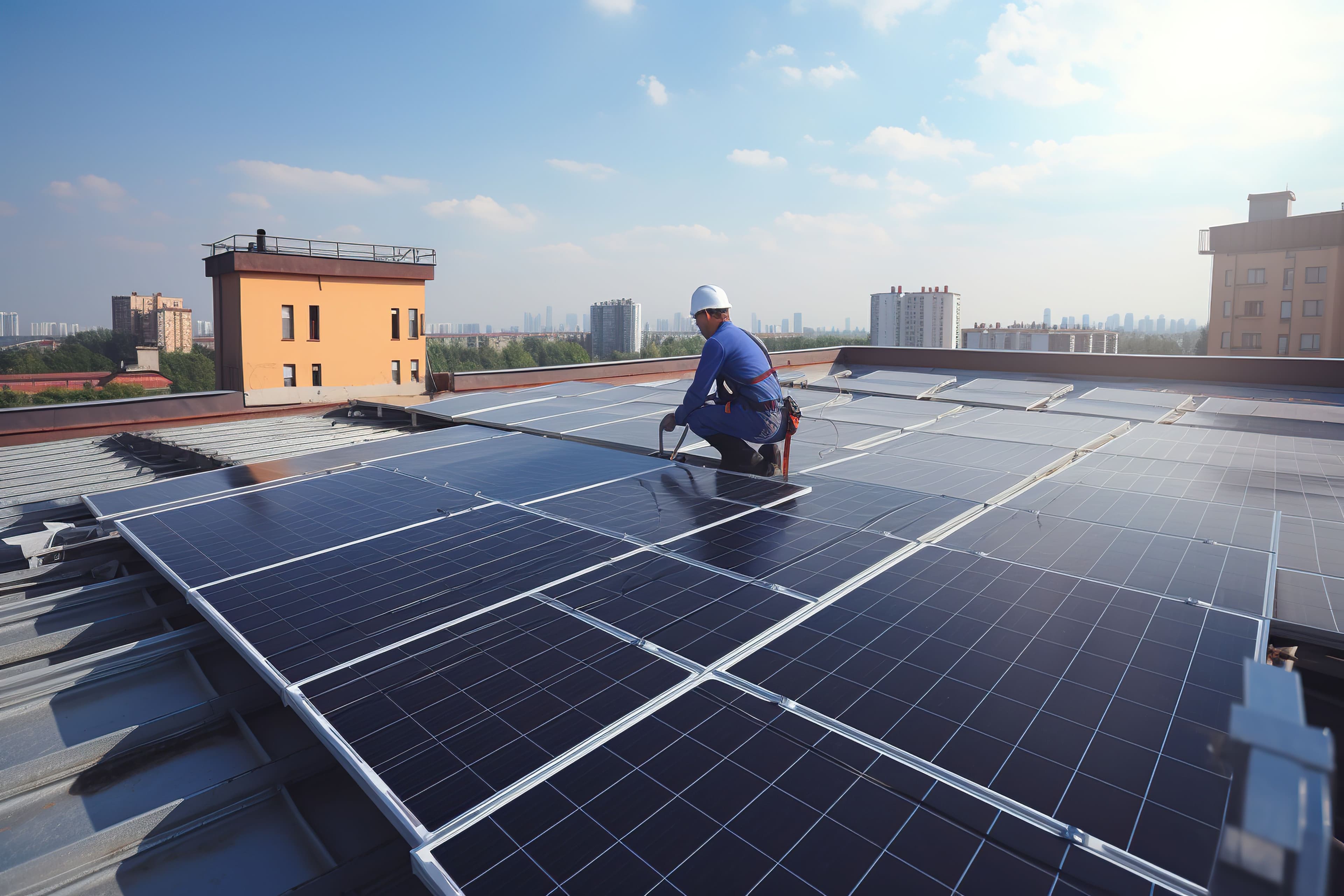
The operation of photovoltaic panels is based on a fundamental principle of physics: the photovoltaic effect. This process, which occurs at the atomic level, is at the heart of generating electricity from solar radiation. Let us dive into the technical process behind this phenomenon.
Photovoltaic Effect: The Capture of Solar Energy
When photons of sunlight strike the surface of a photovoltaic panel, their energy is absorbed by the atoms present in the panel material. This absorption causes the release of electrons from their orbitals, thus generating an electric current. The layers of semiconductor material in the panel are strategically designed to allow electrons to flow in a specific direction, thus creating a continuous stream of usable electricity.
Energy Conversion and Power Generation
The electrons released by the photovoltaic effect flow through an electrical circuit connected to the panel. This electric current is then channeled through an inverter, a crucial component that converts direct current (DC) into alternating current (AC), the form of electricity used in most homes and businesses. In this way, photovoltaic panels not only generate electricity, but also adapt it to meet our everyday needs.
Efficiency Optimization
Solar panel design and technology have advanced significantly to maximize efficiency. Materials such as silicon and anti-reflection coatings are used to increase sunlight capture and reduce energy loss through reflection. In addition, multi-junction solar cells take advantage of different wavelengths of sunlight to generate more electricity. This results in more energy production in a smaller space.
When we talk about the efficiency of solar panels, we are referring to the amount of solar energy they can convert into electricity. In general, commercial solar panels have an efficiency ranging from 15% to 20%. This means that about 15% to 20% of the solar energy incident on them is converted into usable electricity. However, efficiency can vary depending on the technology used in the panels and environmental conditions.
We will not obtain the same solar energy conversion with monocrystalline or polycrystalline solar panels. To know the differences between these types of panels and their efficiency, you can consult our article: Monocrystalline vs. polycrystalline solar panel: Which one to choose?
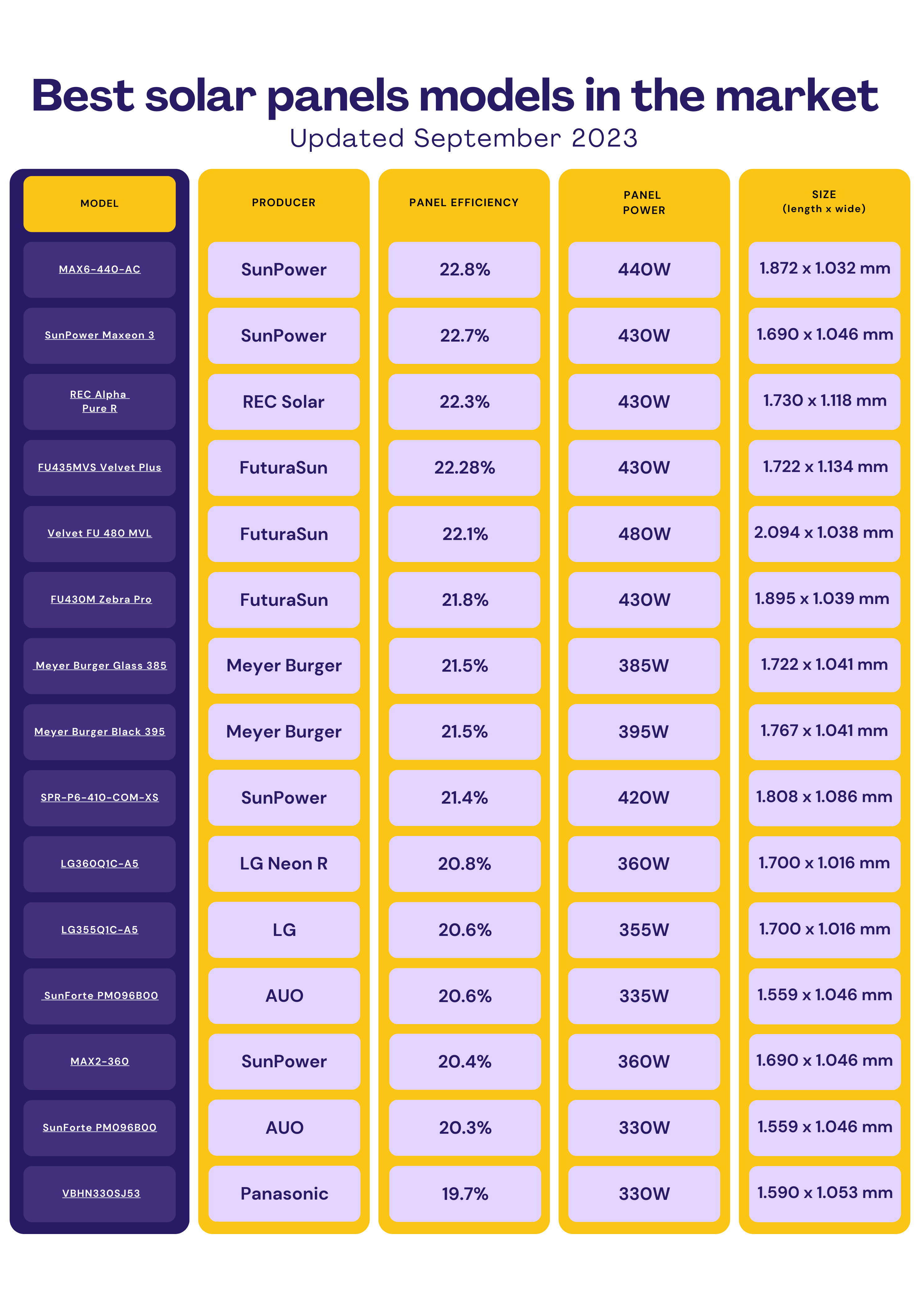
When it comes to choosing solar panels, there are a variety of options that offer unique features and suit various needs. From efficiency to flexibility, each type has its own advantages. Here are the different types of solar panels you can find and their features.
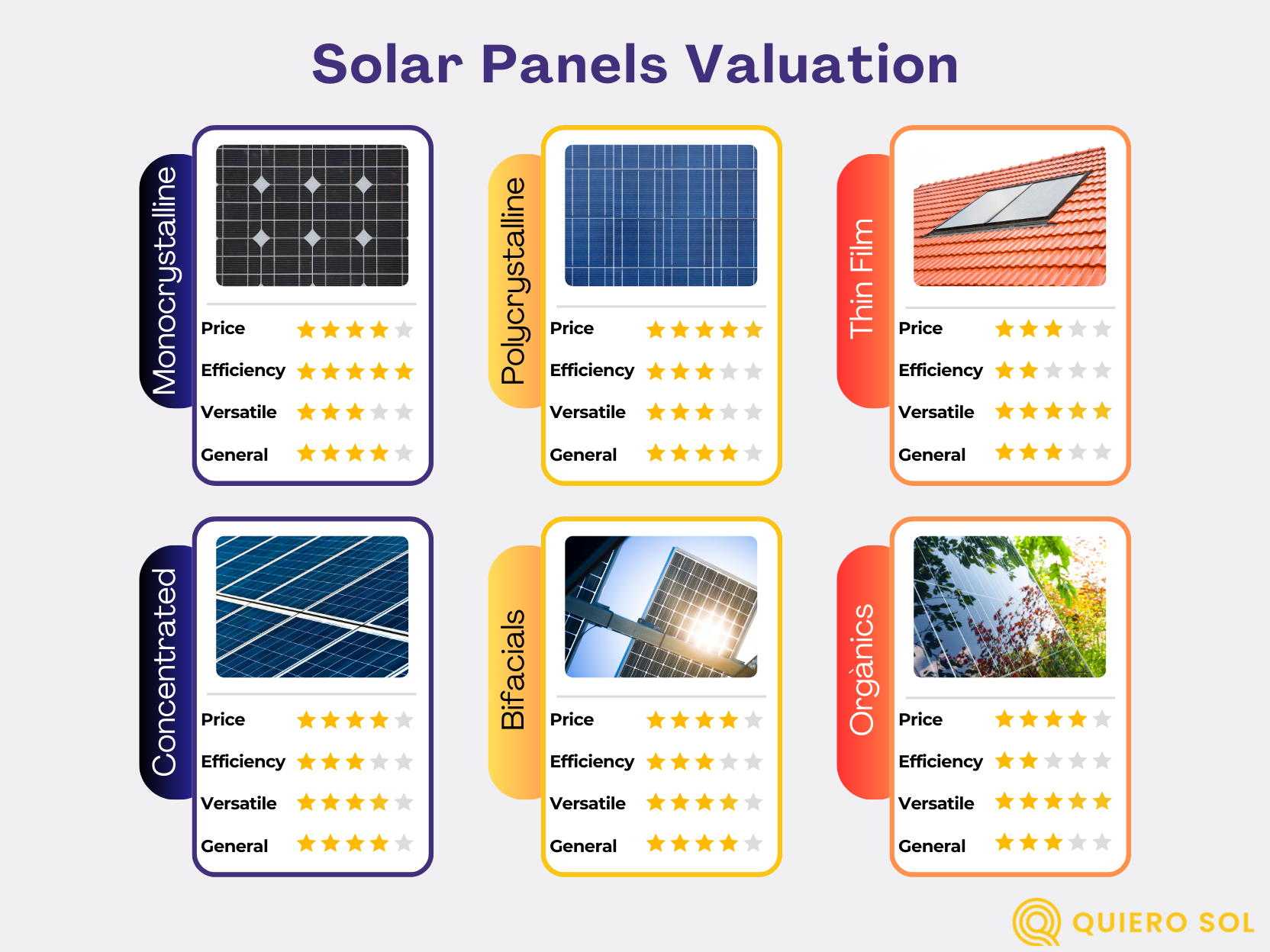
As we have seen in the previous point, choosing the type of plate is vital for the installation you want to be efficient and amortizable. However, in Quiero Sol té we want to give you more information regarding prices and power, so that, now that you know each type of plate that exists in the market, you can choose the one that best suits your needs.
In the following table you will find solar panels price and power.
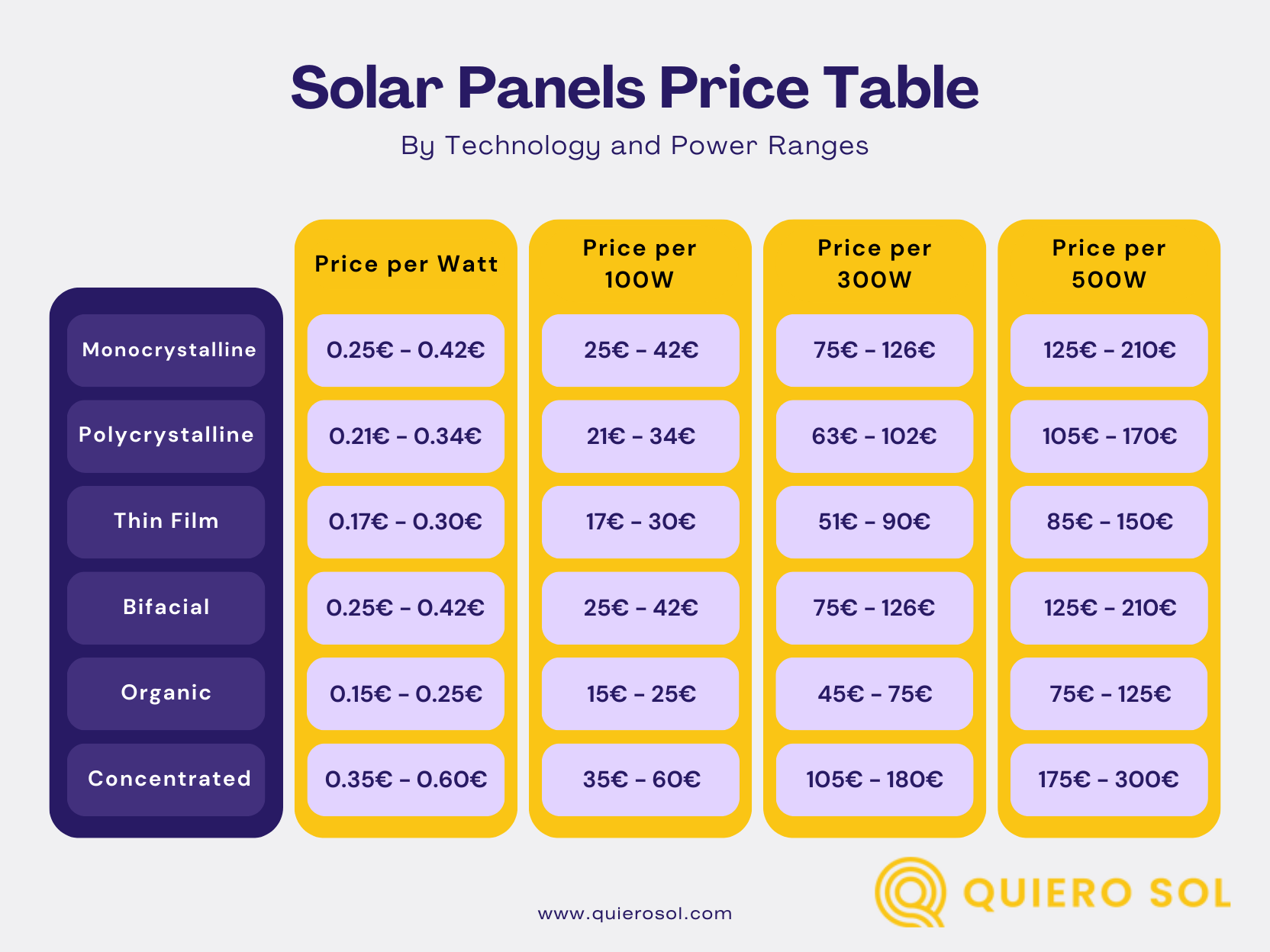
However, there is another type of solar panels, which can be confused with photovoltaic panels, but which are very different. These are solar thermal panels, also known as solar thermal collectors.
Solar thermal panels are devices designed to harness the sun's energy for the purpose of heating water or fluids. Unlike photovoltaic solar panels, which convert sunlight into electricity, solar thermal panels focus on capturing and transferring heat.
These solar thermal collectors are composed of tubes or panels containing liquid or gas, which is heated by absorbing solar radiation. Once heated, the fluid can be used directly for space heating, water heating in domestic systems or even to supply heat to industrial processes.
Solar thermal panels are especially efficient in applications where heat demand is high, such as central heating systems, water heaters and swimming pools. They are also a sustainable and economically viable option for reducing conventional energy consumption and greenhouse gas emissions.
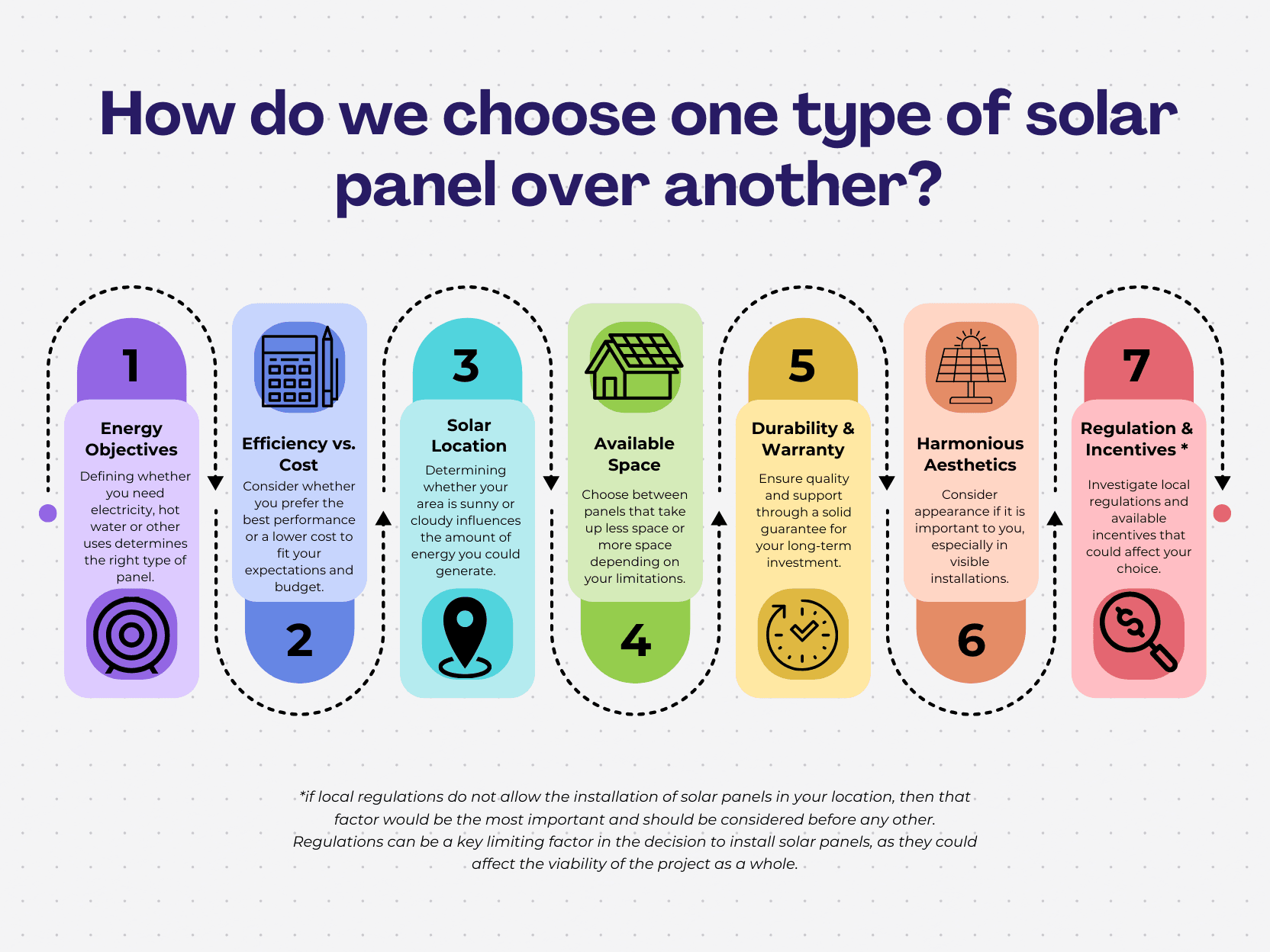
Solar panels are not stand-alone units that work on their own, which is why it is vital to understand solar panel systems, which are made up of essential components that work together to convert solar energy into electricity that you can harness. Below is a detailed breakdown of each of these components:
Opting for solar panels is a smart decision that offers long-term savings on your bills and promotes the use of clean energy without emissions. This choice not only gives you energy independence, reducing your dependence on the grid, but also adds value to your property. It is an investment in both your financial future and the future of the planet. In addition, there are tax incentives and subsidies available that make the price of solar panels even more attractive. The technology in this field is constantly improving, increasing efficiency and cost-effectiveness. By choosing this route, you not only contribute to the environment, but you also feel satisfied for doing so. At Quiero Sol, we facilitate your transition to solar energy by comparing prices and connecting you with the best installers in the market.
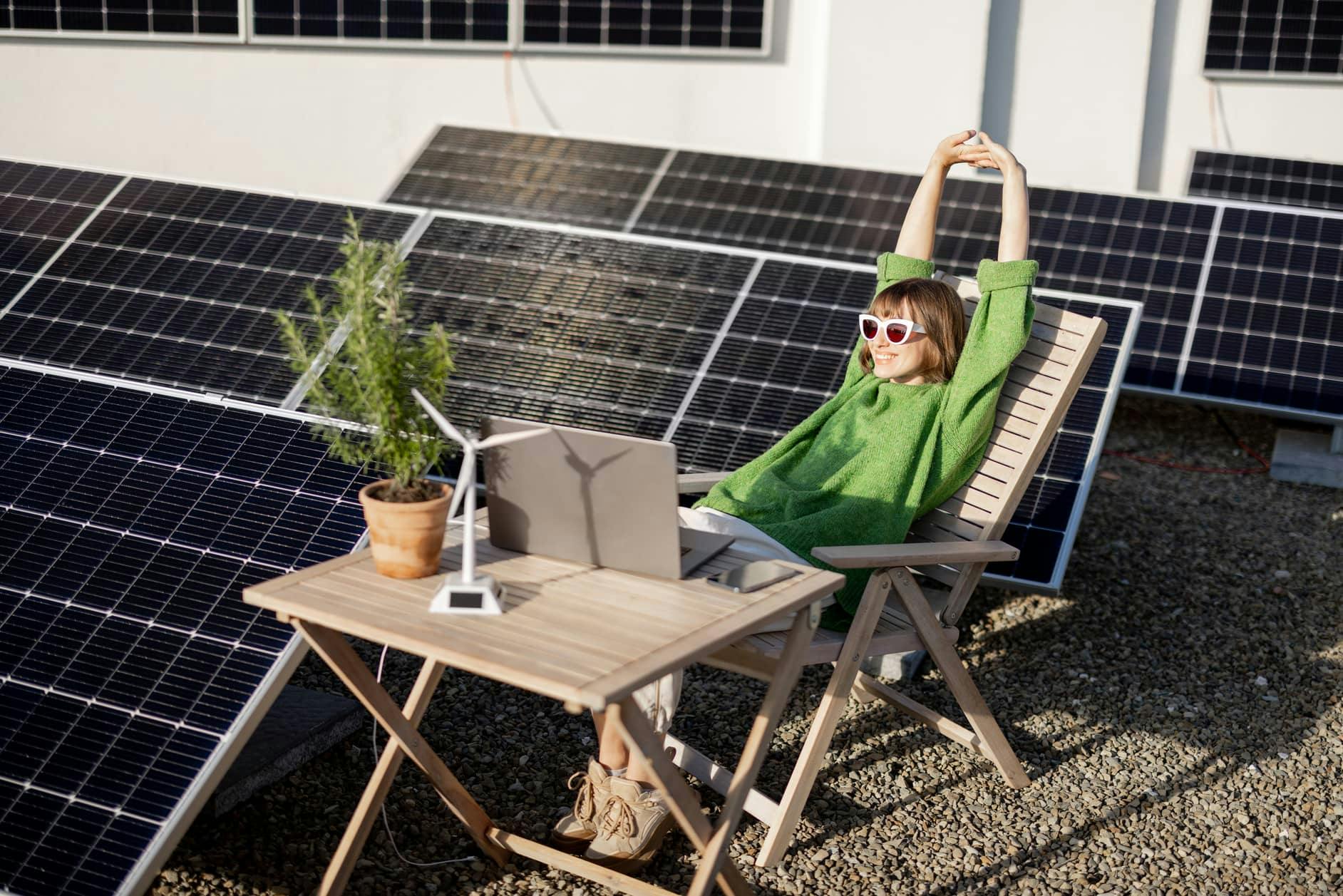
Making the decision of where to buy your solar panels is as vital as choosing which type of solar technology best suits your needs. And here at Quiero Sol, we understand that perfectly. That's why we not only provide you with valuable information, but also connect you with trusted installers for a comprehensive purchasing and installation experience. There are several avenues to purchase these renewable energy units, from specialty stores to websites. In this section, we'll break down the advantages and disadvantages of each option to help you make an informed decision.
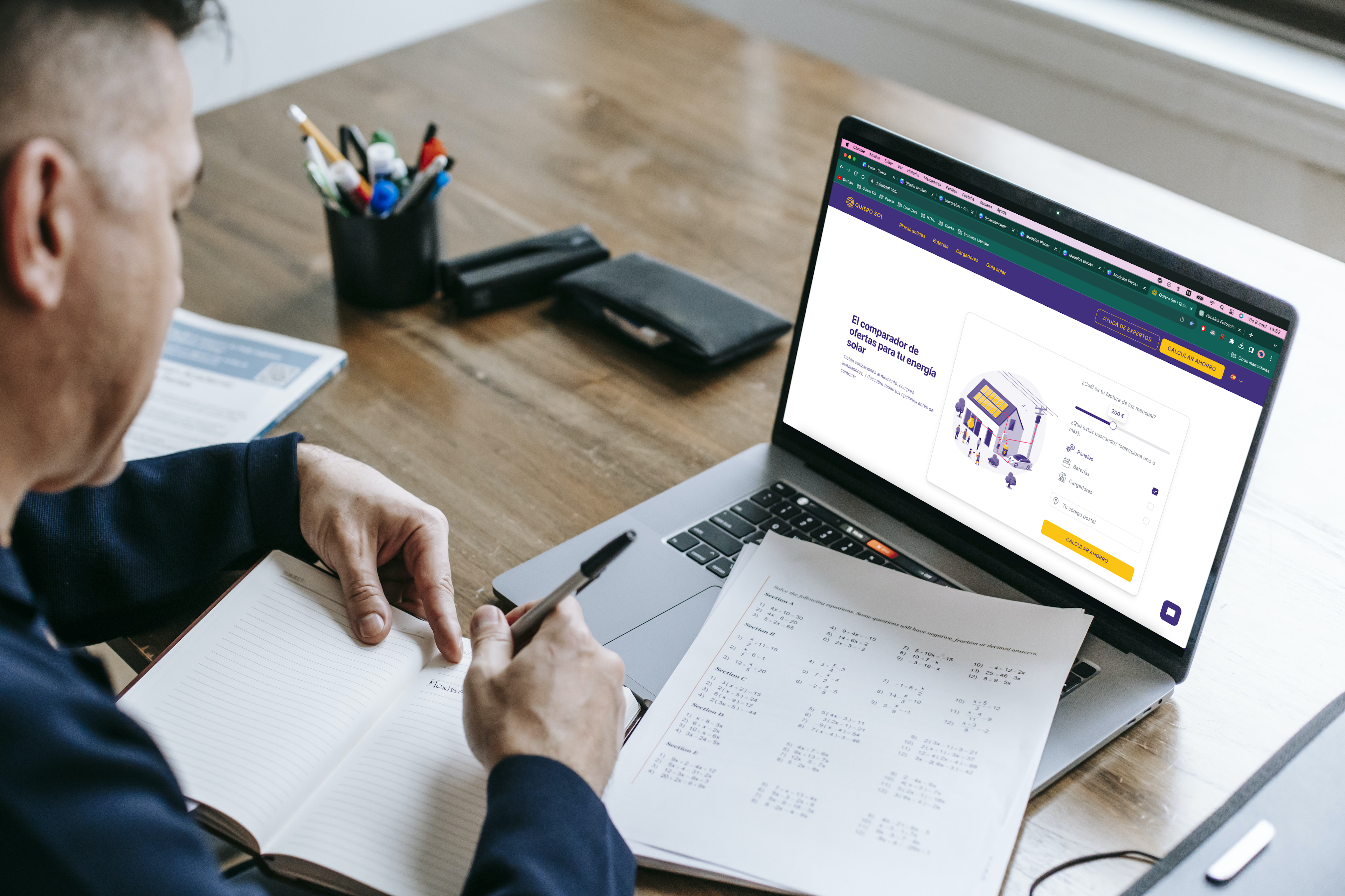
At Quiero Sol, we understand the importance of making informed decisions when considering the purchase of solar panels. As experts in the field, we know that cost is a crucial factor in this choice. Before taking the step towards solar energy, it is essential to keep in mind several aspects that influence the price, many of which we have already discussed on this page. Evaluating your current electricity consumption, selecting the type and efficiency of panels, establishing a total budget and considering the quality and warranty of the products are essential steps in your decision-making process. To these we can add subsidies, geographic areas, etc.
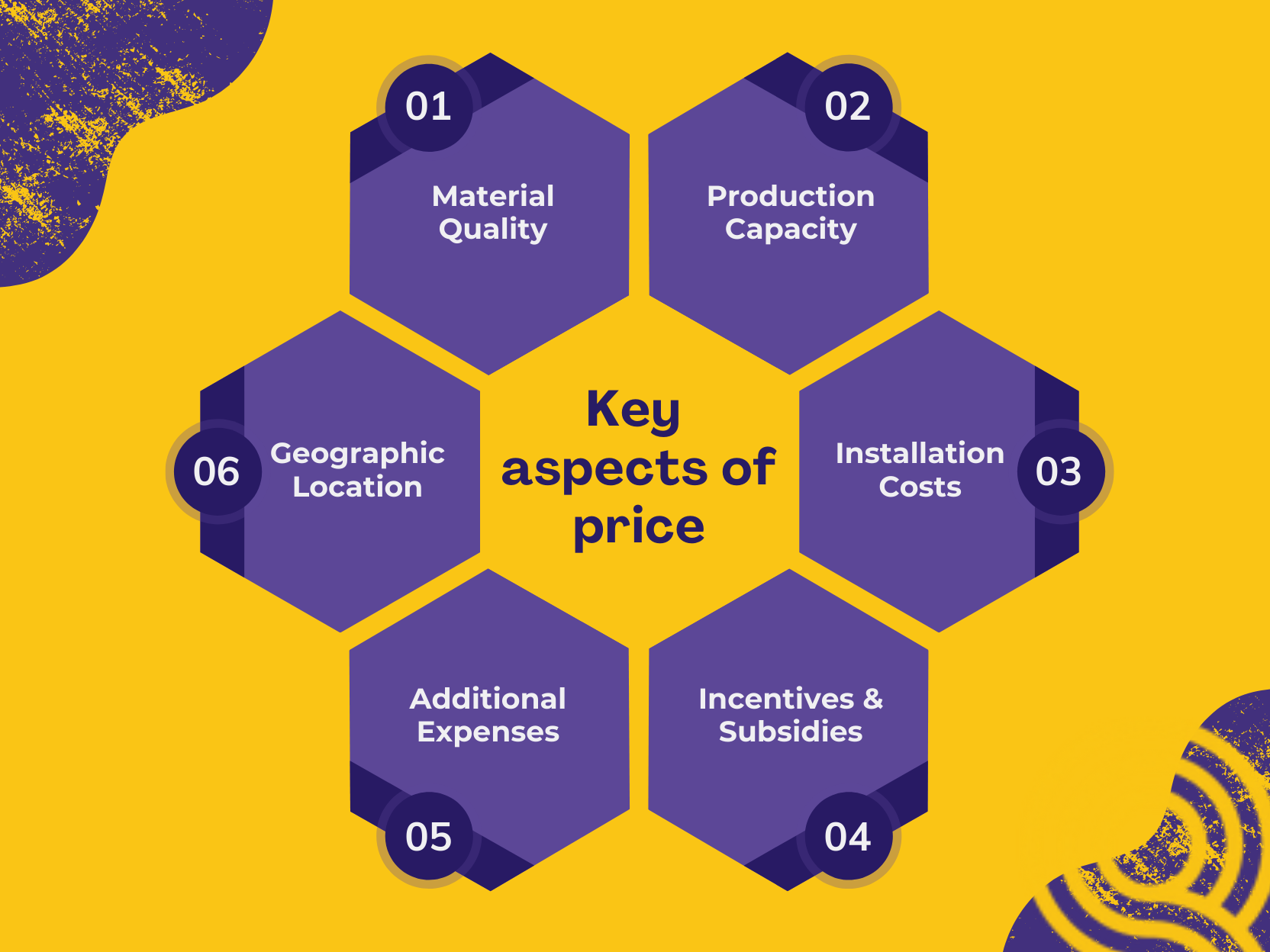
The price of solar panels varies according to several factors. Here are 6 key aspects that affect the price of solar panels.
Solar panel kits are pre-configured assemblies that include all the components needed for a solar power system. They come in various sizes and capacities, facilitating installation with detailed instructions. They can be grid-tied or stand-alone, and prices vary depending on the power and quality of the components. Kits are a convenient way to adopt solar energy and reduce installation costs, but it is important to evaluate your needs and consider professional advice if necessary.
If you want to know more about solar panel kits, prices, sizes, models and which one best suits your needs, you can always contact one of our solar experts to guide you on your path to green energy.
When it comes to installing a solar energy system, one of the first questions that comes up is the budget for solar panels. Understanding the cost structure helps you make an informed investment. Here's a breakdown of the key elements to consider:
At Quiero Sol, we help you compare different options to make sure that your investment in solar energy is the most suitable for your needs and your pocket.
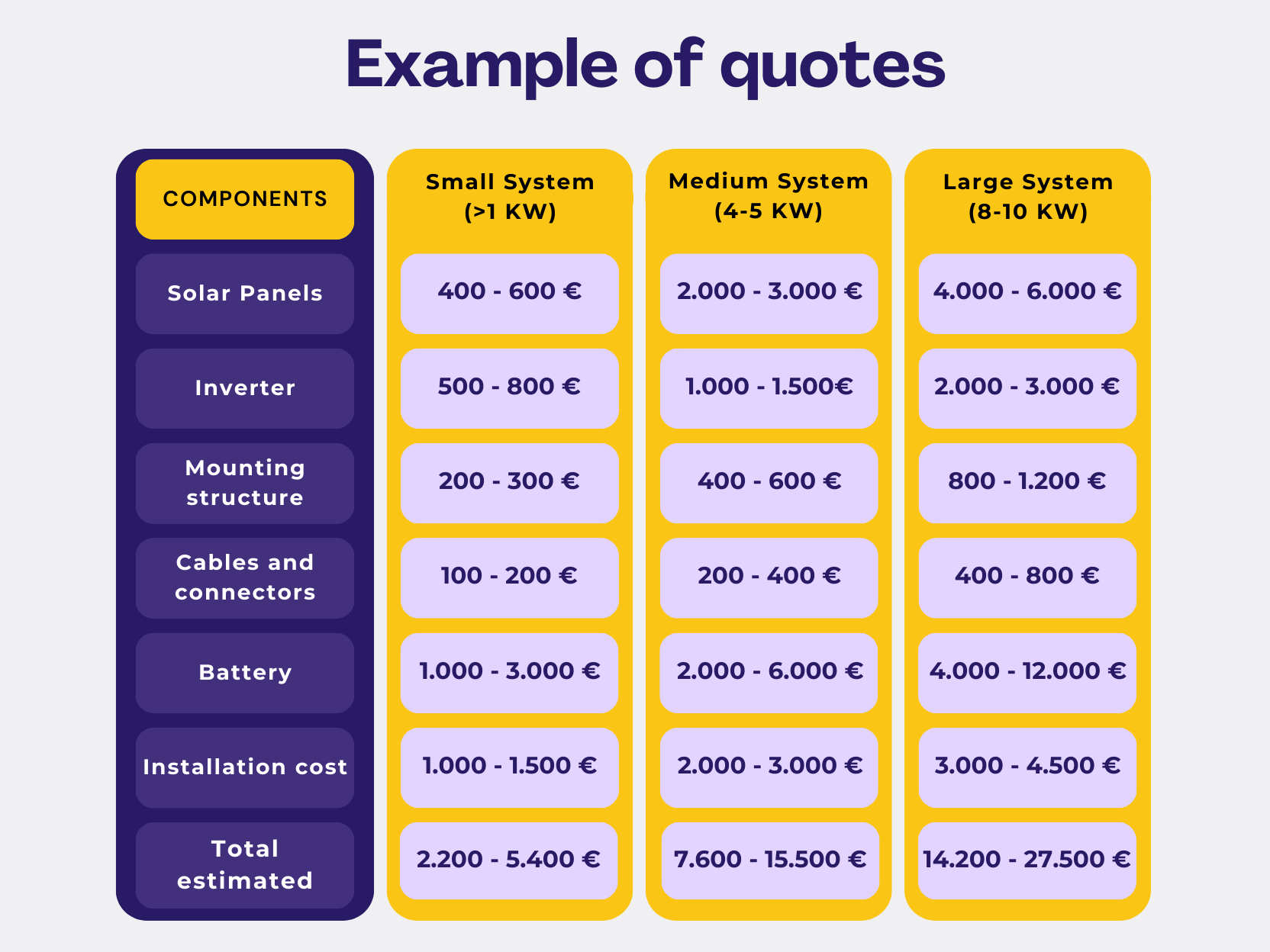
On the road to adopting solar in your home, the fundamental question is not just about the price of solar panels, but about how to choose the best option for your unique space. Every home is different in terms of structure, energy consumption, and environmental conditions. In this section, we will explore how to make informed decisions, considering aspects beyond price. You'll understand how to select the right system based on the shape of your roof, your home's specific energy needs and other key factors. The focus is not just on monetary value, but on how solar panels integrate seamlessly into your home, providing long-lasting and sustainable benefits.
As our solar experts discuss, the number of solar panels you need depends on your energy consumption, the generating capacity of the panels, and factors such as efficiency and location
For starters, you can calculate your monthly consumption in kWh and divide it by the generating capacity of a panel to get an initial estimate. However, this simplistic calculation does not consider factors such as the efficiency of the panels and the geographic location of your home. That's why here we provide you with a progression of different types of homes along with approximate examples of how many solar panels you might need:
Remember that these examples are general estimates and may vary depending on the specific conditions of each situation. Factors such as roof orientation, slope and geographic location also play a crucial role in determining the appropriate number of solar panels. Consulting with a solar professional will provide you with an accurate assessment to make an informed decision tailored to your unique situation.

The price of a solar panel installation is influenced by several factors, including geographic location, type of structure, site accessibility, distance to the electrical connection point, type and quality of inverters and electrical equipment, installation quality, grid requirements, permits and paperwork, warranties and maintenance, as well as available incentives and subsidies. Obtaining multiple quotes from qualified installers is essential to obtain an accurate quote and consider both upfront costs and long-term savings.
In the following section we will explain you the different prices that solar installations can have depending on their components and power range.
In Spain, subsidies for the installation of solar panels may vary in 2023 depending on the region and local government. The Institute for Energy Diversification and Saving (IDAE) and the Autonomous Communities often provide information on support programs for energy efficiency and renewable energy. In addition, some municipalities and energy companies also offer possible subsidies.
If you want to find out about all the subsidies and grants that currently exist for the installation of solar panels, you can consult our article on the subject: Subsidies for solar panels in Spain.
Taxes and regulations applied to self-sufficient electricity grids with solar panels vary by location and local legislation. They may include taxes on power generation, grid connection fees, interconnection regulations and others. There may also be tax benefits and subsidies available in some areas. But don't worry, at Quiero Sol we will inform you about everything related to these taxes. You can start by reading our article about the Sun Tax in Spain, or you can contact us for more information.

Contact one of our solar experts for advice!
The future of solar energy is promising due to steady cost reductions, driven by technological advances and growing environmental awareness around the world. As solar panels become more affordable and efficient, their adoption has accelerated in recent years. In addition, government policies favorable to renewable energy have provided additional impetus to the solar industry.
The ability to store solar energy has also evolved significantly, making it possible to harness the electricity generated during the day even when the sun is not shining. This innovation has increased the usefulness of solar panels, as they can now contribute more consistently and reliably to power generation. As energy demand grows in crucial sectors such as electrification and mobility, solar panels are positioned to play an essential role in expanding the clean and sustainable energy matrix.
If you're wondering about the price of solar panels in 2023 and whether the cost is expected to rise, here's some key information to keep in mind. Our solar market experts have taken a close look at trends over the first three quarters of the year, and the conclusion is encouraging for those interested in solar.
So far, the market has shown a clear downward trend in solar panel prices over the course of the year. This is positive news for those considering adopting this technology, as it indicates that solar panels are becoming more affordable in terms of cost. Technological advances, optimization in manufacturing processes and increasing competition in the sector are some of the factors that have contributed to this price decrease.
Looking ahead to the last quarter of 2023, the outlook remains favorable. Our experts anticipate that the downward trend in solar panel prices will remain steady. This means that, if you are considering investing in solar, now is a good time to explore your options and make informed decisions.
Si quieres más información sobre productos solares, solicita presupuestos con distintos instaladores sin compromiso aquí.